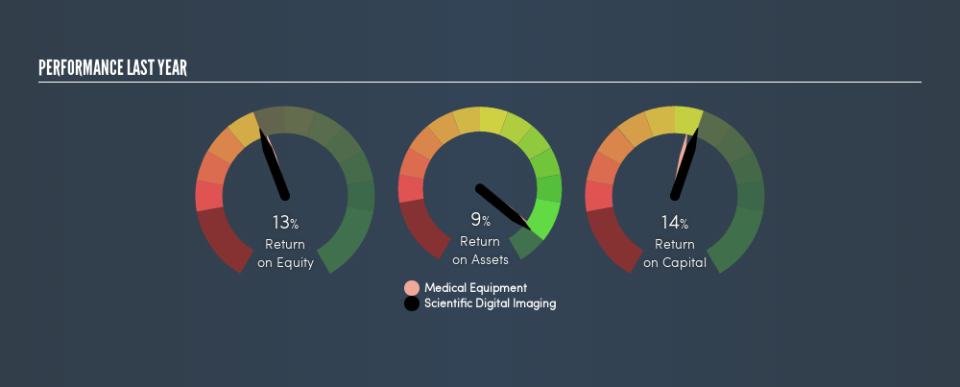Why We Like Scientific Digital Imaging plc’s (LON:SDI) 14% Return On Capital Employed

Want to participate in a short research study? Help shape the future of investing tools and you could win a $250 gift card!
Today we'll look at Scientific Digital Imaging plc (LON:SDI) and reflect on its potential as an investment. Specifically, we'll consider its Return On Capital Employed (ROCE), since that will give us an insight into how efficiently the business can generate profits from the capital it requires.
First of all, we'll work out how to calculate ROCE. Second, we'll look at its ROCE compared to similar companies. Finally, we'll look at how its current liabilities affect its ROCE.
Understanding Return On Capital Employed (ROCE)
ROCE measures the 'return' (pre-tax profit) a company generates from capital employed in its business. In general, businesses with a higher ROCE are usually better quality. In brief, it is a useful tool, but it is not without drawbacks. Author Edwin Whiting says to be careful when comparing the ROCE of different businesses, since 'No two businesses are exactly alike.'
So, How Do We Calculate ROCE?
The formula for calculating the return on capital employed is:
Return on Capital Employed = Earnings Before Interest and Tax (EBIT) ÷ (Total Assets - Current Liabilities)
Or for Scientific Digital Imaging:
0.14 = UK£2.3m ÷ (UK£19m - UK£2.9m) (Based on the trailing twelve months to October 2018.)
So, Scientific Digital Imaging has an ROCE of 14%.
Check out our latest analysis for Scientific Digital Imaging
Is Scientific Digital Imaging's ROCE Good?
One way to assess ROCE is to compare similar companies. Scientific Digital Imaging's ROCE appears to be substantially greater than the 11% average in the Medical Equipment industry. We would consider this a positive, as it suggests it is using capital more effectively than other similar companies. Regardless of where Scientific Digital Imaging sits next to its industry, its ROCE in absolute terms appears satisfactory, and this company could be worth a closer look.
You can click on the image below to see (in greater detail) how Scientific Digital Imaging's past growth compares to other companies.
When considering ROCE, bear in mind that it reflects the past and does not necessarily predict the future. ROCE can be deceptive for cyclical businesses, as returns can look incredible in boom times, and terribly low in downturns. ROCE is, after all, simply a snap shot of a single year. What happens in the future is pretty important for investors, so we have prepared a free report on analyst forecasts for Scientific Digital Imaging.
Scientific Digital Imaging's Current Liabilities And Their Impact On Its ROCE
Current liabilities include invoices, such as supplier payments, short-term debt, or a tax bill, that need to be paid within 12 months. The ROCE equation subtracts current liabilities from capital employed, so a company with a lot of current liabilities appears to have less capital employed, and a higher ROCE than otherwise. To counter this, investors can check if a company has high current liabilities relative to total assets.
Scientific Digital Imaging has total liabilities of UK£2.9m and total assets of UK£19m. As a result, its current liabilities are equal to approximately 15% of its total assets. A fairly low level of current liabilities is not influencing the ROCE too much.
Our Take On Scientific Digital Imaging's ROCE
With that in mind, Scientific Digital Imaging's ROCE appears pretty good. There might be better investments than Scientific Digital Imaging out there, but you will have to work hard to find them . These promising businesses with rapidly growing earnings might be right up your alley.
I will like Scientific Digital Imaging better if I see some big insider buys. While we wait, check out this free list of growing companies with considerable, recent, insider buying.
We aim to bring you long-term focused research analysis driven by fundamental data. Note that our analysis may not factor in the latest price-sensitive company announcements or qualitative material.
If you spot an error that warrants correction, please contact the editor at editorial-team@simplywallst.com. This article by Simply Wall St is general in nature. It does not constitute a recommendation to buy or sell any stock, and does not take account of your objectives, or your financial situation. Simply Wall St has no position in the stocks mentioned. Thank you for reading.

 Yahoo Finance
Yahoo Finance 
